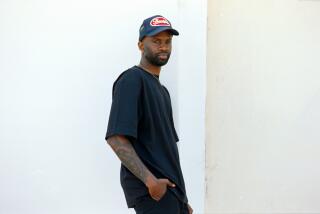Exhibit may leave viewers feeling compromised
Roger Ballen’s photographs are, at their best and at their worst, unnerving. They have the general appearance of portraits but function more like theatrical tableaux or still lifes.
Some become powerful metaphors for victimization, but others seem like prime examples of it. What makes them problematic is that Ballen chooses subjects already compromised by poverty and a range of unstated but apparent ailments and dehumanizes them further by treating them as curious props.
In the split-second glimpse we have of these individuals, they’re not playing out the drama of their own lives but serving as edgy character actors in Ballen’s. Their lives are clearly already devoid of beauty. Ballen too often strips them of dignity as well.
Both the failings and the force of Ballen’s enterprise come across most vividly in his recent work, which dominates his exhibition at the Museum of Contemporary Art San Diego, his first in a U.S. museum. Ballen, who hails from New York, started out making conventionally snappy street photographs in the late ‘70s.
After earning a doctorate in mineral economics in 1981, he moved to South Africa to work in the mining industry. His first photographs there documented poor villages in the style of Walker Evans. The views of weathered facades and dilapidated interiors are insistently frontal, full of texture and the found poetry of signs and wall hangings.
The quiet desperation of these environments gave way to images of their underclass inhabitants -- scruffy children and men who could be cousins to Diane Arbus’ freaks and the inbred Appalachians of Shelby Lee Adams. In one jarring picture, two young men, twins with unnaturally thick necks and protruding ears, stare sternly into the camera while threads of drool hang from their heavy lower lips.
Wall text tells us that Ballen’s publication of these portraits disturbed the South African government. The year was 1994, and the white-ruled apartheid regime was in collapse. Ballen’s pictures, predominantly of dispossessed whites, challenged the government’s claim of Afrikaner strength and superiority.
More than half a century earlier, August Sander’s diverse collective portrait of the German people sent a similar ripple of unrest through his nation’s government, bent as it was on perpetuating the myth of a master race. Sander had to suspend his project, but it remains an incisive study of identity and class. Ballen’s amounts to much less, focused as it is on the odd and sensational, the deviant rather than the typical.
Ballen makes it easy to pity his subjects but gives too little context to provoke the deeper response of compassion. In the new work, shot on the fringes of Johannesburg, Ballen drops the pretense, at least, that the images are portraits and might deliver as such. He regards them instead as “installations,” arrangements made to reflect his own sensibility rather than necessarily depicting any truths about the subjects’ social conditions.
Nearly all of the images adhere to a common formula: a wall behind and people or objects in the shallow foreground, shot frontally in a neutralizing square format. The wall serves as a canvas of sorts, or a sheet of paper, a base upon which Ballen’s imagery rests. It’s always a rich surface, strung with wires, tattooed with graffiti, pocked by time, stained with body oils and grime. Figures in front of the wall assume strange, staged postures. A child raises a wire contraption over a little white mouse on the floor. Another figure, seated on the ground, pulls his head down into his sweater like a turtle retreating into his shell.
A few of the images have a spare, troublesome beauty, like the one of a man tightly wrapped in thick felt, eyeing a swirl of wires that hovers overhead like a personal storm cloud.
Animals show up regularly in these tableaux, frequently as victims of abuse. They are the ultimate innocents here. Their plight carries great metaphorical weight and further complicates the dynamic within the frame -- the empowered photographer shooting a powerless subject victimizing an even more powerless animal. In one photograph, a grinning security guard presses a puppy up against a wall like a crime suspect. In another, a young man rests on a couch, holding a phone to his ear with one hand and with the other gripping the back legs and tail of a cat desperately trying to escape.
Vulnerability and exploitation are Ballen’s tools in trade -- his subjects, his methods, his themes. He makes some powerfully tough pictures, but too often they leave us feeling as compromised as his subjects.
*
Roger Ballen:
Where: Museum of Contemporary Art San Diego, downtown location, 1001 Kettner Blvd., San Diego
When: Closed Wednesdays
Ends: Feb. 16
Contact: (858) 454-3541
More to Read
The biggest entertainment stories
Get our big stories about Hollywood, film, television, music, arts, culture and more right in your inbox as soon as they publish.
You may occasionally receive promotional content from the Los Angeles Times.










